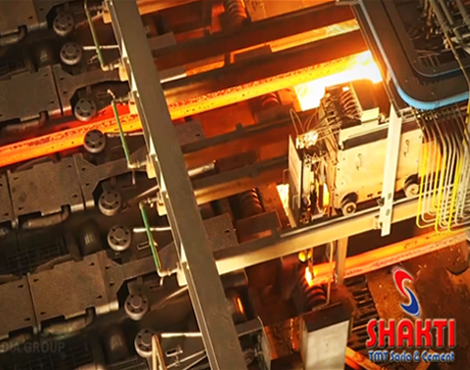- Today's Rate
- Lane No - 4, Phase II SIDCO Industrial Complex, Bari Brahmana, Jammu
PROCESS CONTROL
Process Control at Kashmir Ispat
Process involved in making THERMO MECHANICALLY TREATED (TMT) BARS TMT Steel has to undergo the following processes before attaining its final shape:-
Heating of the Billets :
The billets are first pre-heated in a double layer furnace to a temperature of 11500 C( +,- 500). The burners are installed in the furnace and connected by pipes carrying the fuel and air necessary for heating the Billets. The Billets are pushed into the furnace by means of a pusher run by a motor at the feeding point. At the outlet the hot Billets are taken outwith the help of another pusher operated by an operator for further processing.
Passing of the Hot Billets through various Mills :
The hot Billet has to pass through three mills, which are:-
(1) Roughing Mill.
(2) Intermediate Mill.
(3) Finishing Mill.

The hot Billet first passes through the Roughing Mill where the reduction in its cross-section takes place. It then passes through the intermediate Mill where it is subjected to further reduction. It is only in the Finishing Mill that the Billet gets its required dimension. When the pre-heated Billet from the furnace is introduced into the Roughing Mill, reduction in its cross-section area takes place followed by increase in its length as it passes through the rolls due to the pressure exerted by the rolls. As in this case the elongated metal is passed through each pass manually with the help of tongs. Some space is kept between the rolls which provide the metal rod with the ribs necessary for stability. The selection of the number of stands to be used depends upon the required diameter.
After the Roughing Mill the elongated metal is then passed through the Intermediate Mill where again there is further reduction of the cross-section area and here it is passed through each pass automatically. In between its movement from the Roughing Mill to Intermediate Mill a small portion of the elongated metal rod at the end is cut with the help of a shearing machine. This is done because during the course of its travel through the rolls of the mills, the impurities get concentrated at the end which if not removed will create hindrance in passage of material through different passes.
Finally the metal rod reaches the Finishing Mill where it attains its desired diameter by the passing though the required diameter. In this process, the metal rod passes through the rolls carrying lugs. These lugs give the spiral lining on the metal rods.
Once out of the Finishing Mill the metal rod goes in the quenching box. Water is used for cooking of TMT BARS with the help of Cooling Pipes. The cooling system employed is called Charged Quenching System, which leads to a short and intensive cooling of the surface. Because of the reduction in the temperature at a rate higher than the critical rate for martensite quenching the surface layer of the re-bar is converted to a hardened structure while the core remains austenitic. After the intensive cooling, the bar is exposed to the air and the core reheats the quenched surface layer by the conduction, therefore tempering the external martensite.
The thermal profiles of the Surface and the Core merge at the equalizing temperature that together with the final rolling temperature is the most important parameter to achieve the required mechanical properties. Finally, when the bar is discharged on to the cooling beds, the remaining austenite transforms into a very fine-nozzles, which assure a high degree of heat exchange rate between the cooling water and the traversing bars. Water flow in the Quenching Pipes is designed both in parallel flow and counter-flow, also depending upon different parameters. All the Finished products are subjected various quality checks that is inspection of ribs, lugs, strength and weight per meter to ensure the conformance of standards as laid down in Quality Plan.

